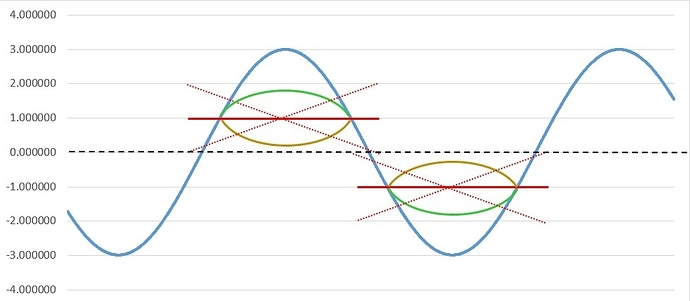specify states as integers, and use these to read relative probabilities from tables (one table per state, and one table entry per state eg. state 3 of reads the 3rd entry from each table). whenever you trigger state change, generate one random value per potential new state. Multiply each one with the read value from the appropriate table, and choose the maximum as your new state.
Wishlist of objects
did you know that @SirSickSik has objects you can Markov chain ...
though i would be really happy about a diffrent approach
Clipping Controller Object.
I expect its not too complicated for some...
The idea is to re-create how diodes may manipulate the clipping of a signal along with control functionality with LFOs etc..
- Controls clipping positive and negative separately with all the following adjust abilities on both poles.
- The level at which it clips is adjustable and can be connected to a K-Rate and or LFO.
- The clipped shape is adjustable from the natural curve to a straight line, to the reverse of the natural curve. The picture I have below helps explain this, the natural curve blue, half way between natural curve to straight line is green, straight line is red (this is also the clipping level) and dark yellow goes into the negative reverse. And all this is adjustable to a K-Rate or LFO.
- One last idea is shown as the dotted red lines, and this is putting an angle on the red straight line clipping angle, which is also adjustable to a K-Rate or LFO.
So their will be 6 dials, 2 unipolar adjusting the clipping levels on both poles, and 4 bipolar adjusting clipping curve, and clipping angle. 
Something like Max/DSP groove~ object with tempo/pitch and start/end sample position (without noise manipulating live?)
Is there something already made?
I think building a positive or negative clipping module at k-rate will be easy. Of course this will be flat clipping.
If (input > clip_pos) clip_pos
else if (input < clip_neg) clip_neg
else input;
Could easily be reproduced with logic modules me thinks.
The curve idea will take more math than I'm capable of. 
Have you given it a shot?
is there in the meantime an object that can use scala format? i cant find anything. or any work around that you came up with? thanks jens
I've been unable to use axoloti wth micro tunings. Unfortunately it's been a year and a few months since I requested the object. I must admit my axoloti has been sitting on the shelf most of this time. I fell down the eurorack hole and haven't been able to get out 
can you not just implement the (microtonal) scale using a divrc object into a mux, where you feed the mux with the degrees of the scale - seems the simplest solution to me.
(you could save different presets with different scales if you need to)
id personally not want to do file parsing (eg. scl files) in Axoloti as the code required is 'relatively' large and you only really use once at, so its a waste of memory in the code region that could be used other things (oscillators,sequencers,fx or whatever)
it would however be pretty trivial to take a simplified format, e.g. decimal specifications only as a comma separated list....
at musichackday one year ago johannes made an object that (or rather implemented it from another open source plattform) that can load scala files.
unfortunately I can't find the patch anymore. I'm sure though it's somewhere on my harddrive!
Personally I would agree that it would be much cooler to do it live in the patch. I would love to build something inspired by the quanoun where you can adjust the tuning of your scale as part of the performance.
thanks technobear, comma separated lists sounds good to me. though, since i am not a programmer i have no idea how to implement one. could you explain it a bit more detailed please. or demonstrate it even with a list of some frequencies... if it is easy (which i believe) just need to get my head around it, i guess...
Has any made something like a Buchla Source Of Uncertainty?
I'm having a great time with Encoder Audio's Max For Live version
Here's some objects I wish existed.
LFO with PWM and Logic output.
Falling edge detection - generate trigger on falling edge
Divide 2 integers with float output
Display Unipolar Float number value - not as pitch or frequency
Knob with range and step size
Multiple input OR gates
"Falling edge detection - generate trigger on falling edge"
- Just invert the trigger signal, so the falling edge becomes a rising edge.. !
Thanks Gavin, I've found a few ways of doing it since I made that post. Some of the objects on that list are already there in the library I just hadn't found them.
A really smart object that detects all available controls on axo's outputs and lets you assign objects to them via a dropdown menu. E.g. An object with X inputs and a dropdown menu showing available controls (hardware -direct or multiplexed- , midi controller buttons, pads, sliders etc).
a multi-line textobject (with maybe basic color and font settings), they will be great for documenting help patches 

